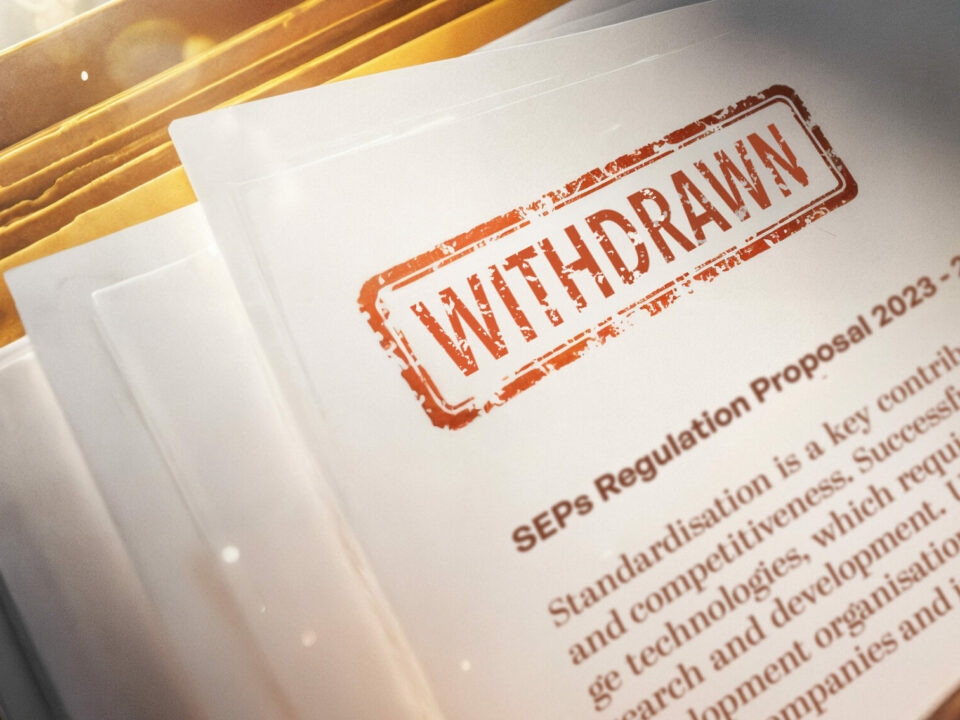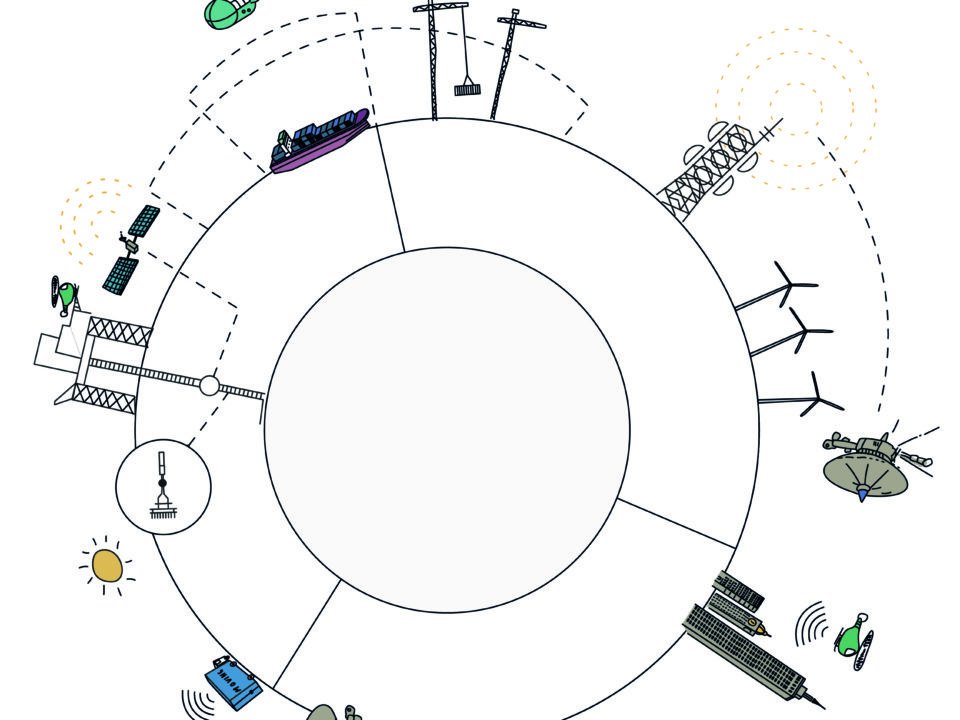Open letter fact-checking European automakers’ recent false claims about patent licencing
IP Europe has sent the following letter fact-checking European automakers’ recent false claims about patent licensing to the intellectual property experts of all European Union member states.
To whom it may concern,
IP Europe is a coalition of R&D-intensive organisations that champions the innovation and open standards ecosystem, which enables the development of cutting-edge technology, drives private investment in R&D-intensive sectors and delivers innovation and growth for EU citizens and businesses.
We are writing in response to the recent open letter from the European Automobile Manufacturers’ Association (ACEA) that asked you to object to the European Commission’s intended withdrawal of the proposal for a Regulation on the licensing of standard-essential patents (SEPs) that it proposed in April 2023.
In advocating in favour of retaining the proposal, ACEA’s letter relies on a number of false and misleading claims, notably as regards automotive companies’ access to standardised technologies and FRAND (fair, reasonable and non-discriminatory) licensing rates.
In particular, we would like to draw your attention to the following:
Access to standardised technology is not inhibited
ACEA contends that the proposed SEP regulation is necessary to provide access to standardised technology. This is false.
Automotive companies have long benefited from access to standardised technologies. They have included cellular connectivity in automobiles, and have profited from those technologies, since the early 2010s[i]. As of September 2022 Avanci, the leading SEP licensing platform, announced that it had licensed the majority of vehicle manufacturers, including all ACEA members, for 4G technologies[ii]. This clearly shows that access to technology has not been impeded and does not require regulatory intervention.
Fair royalties are mischaracterised as ‘unfair’
The ACEA letter suggests SEP holders try to obtain royalties that exceed the value of the technology.
Automakers currently generate a significant amount of revenue from connected car services – currently generating around $120 per vehicle per year. That is to rise to $1,600 per vehicle per year.[iii] Automakers have made clear that they intend to use cellular connectivity to generate new revenue streams.[iv] The profit margins on these revenues are substantial[v]:
- Stellantis estimates a 40% gross margin on connected car services.[vi]
- Mercedes-Benz charges from € 89 to €329 per year for its connectivity services.
- BMW offers automatic, over-the-air map updates for €90 per year. Having an internet connection in a car to browse the Web can cost between €9.95 to € 34.95 per month.
By contrast, Avanci licenses 2G–5G connectivity for a one-time licence fee of $20–$32 per vehicle, which equates to just $1.67–$2.67 per year over the average 12-year vehicle lifespan. In fact, most car manufacturers took a licence through Avanci at the reduced rate of $15 for 2G-4G or $29 for 2G-5G. This is a fraction of what consumers currently pay automakers for features enabled by connectivity in their cars. These figures clearly demonstrate that SEP royalties are modest and proportionate to the value delivered and extracted by automakers.
The Annex to this letter addresses these and other misleading statements in the ACEA letter. ACEA’s misleading claims undermine their justification for the reinstatement of the proposed SEP regulation.
Priorities of the new Commission
Two of the European Commission’s key priorities are to enhance Europe’s competitiveness by removing red tape and to improve Europe’s defence and security. Unfortunately, the proposed SEP regulation was inconsistent with both goals.
The proposed SEP regulation would have created a massive new bureaucracy at the EU Intellectual Property Office (EUIPO), which would have competed with, duplicated, and thus undermined, existing European institutions such as the EPO, the UPC, European courts and ETSI.[vii] The draft Regulation also would have imposed extensive costs and administrative burdens on European leaders in 5G/6G.
In addition, the draft Regulation lacked concrete measures to support European participation in standardisation and risked undermining European investment in 5G/6G technologies. These technologies are critical to Europe’s economic, defence and security interests. This is notably true as much of our wired and proprietary wireless communications will be replaced by 5G and 6G[viii] and because Europe’s military applications increasingly rely upon 5G and, in the future, upon 6G.[ix]
Conclusions
Experts in the field, including representatives from the UPC and EPO, have welcomed the withdrawal of the SEP regulation.[x] The members of this organisation, which actively contribute to the global standardisation ecosystem, also support the withdrawal. Indeed, we rely on SEP licensing to invest in R&D and maintain European leadership in key standardised technologies, including 5G and 6G, one of the few domains in which Europe remains a technology leader.
While reinstating the proposed SEP regulation might be in the automotive industry’s interest, it is not in Europe’s interest. Accordingly, we ask you to scrutinise their arguments as we have.
We share the Commission’s goals for more transparent and efficient licensing of standard-essential patents. However, the proposed regulation would not have delivered on these objectives. Its withdrawal is thus a positive and forward-looking decision. As Europe intensifies efforts to boost investments in R&D, reinforce its leadership in critical technologies, and enhance competitiveness and resilience, it is important to build on existing strengths. These include world-class institutions such as ETSI, the EPO and the UPC.
IP Europe remains ready to engage constructively with the Commission and other stakeholders to deliver a fair and balanced framework for the licensing of SEPs that supports the continued development of global open standards.
Sincerely,
IP Europe
6 June 2025
Scroll down to the Annex below to see additional false claims and corresponding reality checks!
[i] Connected cars: Timeline, Verdict (15 December 2020), available here: https://www.verdict.co.uk/connected-cars-timeline/?cf-view.
[ii] https://www.avanci.com/2022/09/21/avanci-expands-4g-coverage-to-over-80-auto-brands/.
[iii] Car Companies Can Generate $1,600 Per Car In Future From Connected Car Services, Forbes (24 April 2024) by Sarwant Singh. Available here: Car Companies Can Generate $1,600 Per Car In Future From Connected Car Services
[iv] “We actually are now focusing with those ‘functions on demand’ on software and service-related products, like driving assistance and parking assistance, which you can add later after purchasing the car, or for certain functions that require data transmission that customers are used to paying for in other areas,” BMW’s Heated Seat Subscription Is Dead; Others Live On, Edmunds (27 September 2023), available here: https://www.edmunds.com/car-news/bmw-relents-on-heated-seat-subscription.html
[v] “Connectivity services can pave the way for short-term profitability since they require relatively low initial investments, provide high margins, create recurring revenue streams, and have faster development timelines (as compared with many technologies). Simultaneously, mobility companies must invest in long-term technological advancement (especially in electrical and electronic (E/E) architecture and software) in order to remain competitive.” Connected Data Creates Value for the Automotive Industry, Entrapeer (11 October 2023) emphasis added. Available here: Connected Data Creates Value for the Automotive Industry | Entrapeer.
[vi] The Future of Automotive, Changing the way cares are built, use, and sold in a connected world, KPMG (May 2023). See page 13 and footnote 63. Available here: https://assets.kpmg.com/content/dam/kpmg/xx/pdf/2023/05/future-of-connected-enterprise-for-automotive.pdf.
[vii] Representatives of each of these institutions have objected to the proposed SEP regulation and/or welcomed its planned withdrawal. See IP Europe Live Blog, available here: https://ipeurope.org/blog/live-blog-third-party-comments-on-the-european-commissions-seps-proposal/.
[viii] See, The Reasons For The Withdrawal Of The Commission’s Proposed SEP Regulation, Section 2.5.3 Economic Security, Les Nouvelles, available here: https://lesi.org/events/les-nouvelles-live-spotlight-on-the-march-2025-edition/.
[ix] Drivers of 5G Adoption in the Military, Maris, available here: https://www.maris-tech.com/blog/5g-in-defense-revolutionizing-military-connectivity-and-operations/.
[x] At an EPO-organized event on 14 May, Klaus Grabinski, President of the Court of Appeal of the Unified Patent Court (UPC), welcomed the European Commission’s decision to withdraw the SEP proposal, describing it as “good news” and highlighting the significant legal and practical challenges the draft regulation had posed. Available here: Patents, standards and innovation: securing Europe’s competitive edge | epo.org.
Annex – Fact-checking other ACEA claims
In addition to the misleading claims addressed above, this annex provides a fact-check of other assertions ACEA made in its letter – many of which are frequently echoed in the broader public debate and therefore warrant correction.
Claim 1: “The proposed Regulation …. should put an end to the frequent litigation that has made the licensing environment in Europe so unpredictable and that has held back innovation in this area.”
Empirical evidence from the Commission’s study found that litigation is rare, with the vast majority of licensing agreements concluded amicably.[i] The prevalence of litigation was estimated between 1 and 3 cases per 100 licences for major SEP holders. The study by the European Patent Office (EPO), published this May, found 101 SEP disputes in the period of 2015-2025, or approximately 10 disputes per year.[ii] In comparison, literally thousands of licensing agreements are concluded by SEP holders (bilaterally and through patent pools/platform solutions). These confirm that SEP litigation is rare and only the last resort.
Claim 2: “[auto sector] currently suffers from the fact that SEP holders refuse to provide licences to automotive suppliers.”
SEP holders provide access to the standardised technologies, assuring that all companies in the supply chain have access to the standard. Nothing prevents automotive suppliers from using standardised technologies in their components.
Neither competition law, nor SDO IPR Policies mandate a specific point in the supply chain where to license. Courts have confirmed this approach.[iii]
It is notable that the Commission’s SEP Expert Group acknowledged the principle of licensing at a single point in the supply chain, that the FRAND royalty should be the same irrespective of the level of the production chain used for licensing and that royalties are a cost element that should be passed on downstream.[iv]
Claim 3: “They [SEP holders] threaten vehicle manufacturers who use their technologies with injunctions, forcing them to make excessive royalty payments to avoid time-consuming and costly litigation or production stoppages.”
No one can be excluded from the market without a court first evaluating the situation. The courts assess whether the parties have complied with the CJEU’s Huawei v ZTE negotiations framework,[v] which establishes mutual duties to incentivize good faith negotiations. In cases where the implementer indicates a willingness to take a licence, the court will assess the offer and will not grant injunctions unless a FRAND license is available and has been refused.
Claim 4: “Most of these SEP holders are non-European companies.”
IP Europe, which represents leading SEP holders, includes many European companies and research organisations such as Ericsson, Fraunhofer, Nokia, Orange, and Philips. They hold valuable SEP portfolios for connectivity standards. Furthermore, Ericsson and Nokia are leaders in 5G/6G and trusted European suppliers of network infrastructure. This makes them crucial to European national and economic security. They rely on FRAND licensing to sustain their R&D investments to maintain their leadership in 5G/6G.
Moreover, because most SEP licensees are non-European, the EU is a net beneficiary of SEP licensing revenues.
Claim 5: “Other world regions … have already taken regulatory measures to address these issues.”
No other jurisdiction has taken regulatory measures as intrusive as the European Commission’s proposed SEP Regulation. On the contrary, the US withdrew its policy statement[vi] and has adopted a case-by-case analysis under the existing antitrust rules.[vii] In China, the recently adopted SAMR guidelines on SEPs advocate for good faith negotiations rather than complex regulation. In the UK, the patent office (the UKIPO) has recently set up a SEP Resource Hub, a “collection of guidance and signposting to help UK businesses navigate the SEPs ecosystem”.[viii]
[i] Justus Baron et al., ‘Empirical Assessment of Potential Challenges in SEP Licensing’ (2023).
[ii] European Patent Office, ‘Standards and the European Patent System’ (May 2025).
[iii] Nokia v. Daimler, District Court (Landgericht) of Mannheim, 2 O 34/19 (18 August 2020); Sharp v Daimler, Munich I Regional Court 7 O 8818/19(10 September 2020); Federal Trade Commission v Qualcomm, 969 F.3d 974 (9th Cir. 2020); Continental v. Avanci. No. 20-11032 (5th Cir. 2022).
[iv]European Commission’s SEPs Expert Group Report (2021) p 84-85, https://ec.europa.eu/docsroom/documents/45218/attachments/1/translations/en/renditions/native.
[v] C-170/13 Huawei v ZTE, ECLI:EU:C:2015:477.
[vi] See, DOJ abandons Draft 2021 Statement and withdraws 2019 Statement on SEPs, IP Europe Blog (21 June 2022), available here: https://ipeurope.org/blog/doj-abandons-draft-2021-statement-and-withdraws-2019-statement-on-seps/.
[vii] In arguments before the World Trade Organisation, the European Commission, on behalf of the European Union in a case against China, argued that a recent Chinese decision “effectively deprived” the owners of standard-essential patents “of the rights conferred upon them by the TRIPS agreement. Such a restriction on the exercise of the rights of SEP owners can only be justified in exceptional cases, assessed on a case-by-case basis, if the SEP owner’s use of procedures for patent enforcement is in itself vexatious, oppressive or otherwise abusive.” See IP Europe Live Blog available here: https://ipeurope.org/blog/live-blog-third-party-comments-on-the-european-commissions-seps-proposal/.




